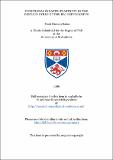Files in this item
Functional synaptic plasticity in the dentate gyrus of the rat hippocampus
Item metadata
| dc.contributor.advisor | Morris, Richard | |
| dc.contributor.author | Baker, Mark Dickens | |
| dc.coverage.spatial | 210 p. | en_US |
| dc.date.accessioned | 2018-07-06T08:25:38Z | |
| dc.date.available | 2018-07-06T08:25:38Z | |
| dc.date.issued | 1986 | |
| dc.identifier.uri | https://hdl.handle.net/10023/15024 | |
| dc.description.abstract | The responses of hippocampal cell fields to stimulation of afferent pathways projecting from outside and within the hippocampus have been shown to exhibit a remarkable degree of plasticity. Subsequent to conditioning stimulation of either single shocks or trains of stimuli at high frequency, the relationship between afferent stimulus and postsynaptic response can be dramatically changed. The long-term potentiation (LTP) of responses generated by stimulus trains does not appear to involve whole-neurone excitability changes, but is the result of altered synaptic effectiveness and can be localized to the region of afferent fibre termination. In a series of acute experiments extracellular potentials generated by stimulation of the entorhinal projection to the dentate gyrus of the hippocampus in the rat, have been recorded in the dorsal hippocampus and quantified before and after conditioning stimulation. A simple computer model was developed to help explain the observed response plasticity. Synaptic field potential LTP after afferent tetanization was explained by increased synaptic current flow, and the altered spatial distribution of the potentials by suggesting that the electrotonic properties of the granule cell dendrites are changed by repeated synaptic activation: an increase in dendritic membrane resistance being a possible mechanism. Light-microscopic examination of the entorhinal fibres at the site of stimulation in the angular bundle after staining with solochrome cyanine, revealed heterogeneous myelination; the fibres lying dorsal and lateral to the subiculum being more heavily myelinated than those more ventro-medial. This histological inhomogeneity appeared to be confirmed by conduction velocity measurements, suggesting two functionally different groups of fibres. It has yet to be determined whether these two groups correspond to the lateral and medial perforant paths described by other workers. | en_US |
| dc.language.iso | en | en_US |
| dc.publisher | University of St Andrews | |
| dc.subject.lcc | QL937.B2 | |
| dc.subject.lcsh | Vertebrate | en |
| dc.title | Functional synaptic plasticity in the dentate gyrus of the rat hippocampus | en_US |
| dc.type | Thesis | en_US |
| dc.type.qualificationlevel | Doctoral | en_US |
| dc.type.qualificationname | PhD Doctor of Philosophy | en_US |
| dc.publisher.institution | The University of St Andrews | en_US |
This item appears in the following Collection(s)
Items in the St Andrews Research Repository are protected by copyright, with all rights reserved, unless otherwise indicated.

